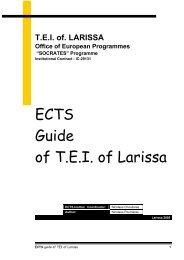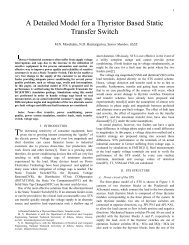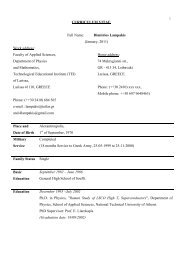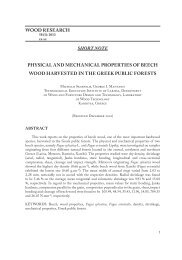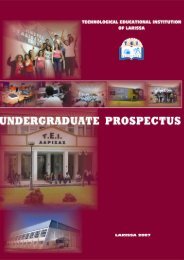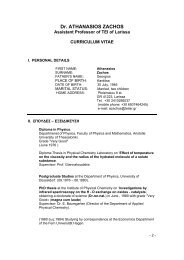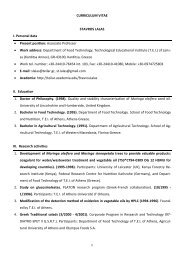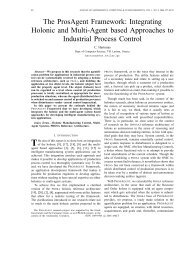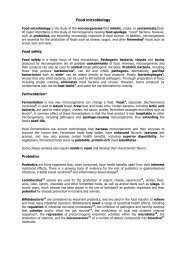Opportunities and barriers for niche marketing of lamb in European ...
Opportunities and barriers for niche marketing of lamb in European ...
Opportunities and barriers for niche marketing of lamb in European ...
Create successful ePaper yourself
Turn your PDF publications into a flip-book with our unique Google optimized e-Paper software.
Agrarwirtschaft 50 (2001), Heft 5, pp1-9.attitudes <strong>of</strong> what constitutes quality <strong>and</strong> the paper discusses the opportunities thiscreates <strong>for</strong> establish<strong>in</strong>g a <strong>niche</strong> market <strong>for</strong> selected livestock products produced <strong>in</strong>these areas.Materials <strong>and</strong> methodsIn order to compare <strong>and</strong> contrast consumer attitudes to product quality, four studyregions have been considered, each <strong>of</strong> which is both an LFA <strong>and</strong> an area much visitedby tourists <strong>for</strong> its natural beauty. The areas chosen are the Loch Lomond ParkAuthority area <strong>of</strong> Scotl<strong>and</strong>, the Rhön Biosphere Reserve <strong>in</strong> Germany, the Pertoulivalley <strong>in</strong> Greece, the Luberon Regional Park <strong>in</strong> France <strong>and</strong> the Matese Massif <strong>of</strong> Italy.All these regions produce <strong>lamb</strong>. Consequently, this commodity was chosen as theproduct used to assess the regional characteristics <strong>of</strong> the market.A r<strong>and</strong>om survey <strong>of</strong> consumers was carried out, between autumn 1997 <strong>and</strong> earlysummer 1998, with<strong>in</strong> the study area <strong>and</strong> the nearest large town or city to the studyarea. In Scotl<strong>and</strong>’s case the nearest city was Glasgow, <strong>in</strong> Germany the BiosphereReserve Rhön, <strong>in</strong> France the National Park Lúberon, <strong>in</strong> Italy the Molise mounta<strong>in</strong>s<strong>and</strong> <strong>in</strong> Greece the Pertuli area. The survey was targeted at consumers between theages <strong>of</strong> 18 <strong>and</strong> 75 who purchased <strong>lamb</strong>. The structure <strong>of</strong> the sample is shown <strong>in</strong> Table1.[Table 1]3
Agrarwirtschaft 50 (2001), Heft 5, pp1-9.ResultsA series <strong>of</strong> common questions were asked <strong>in</strong> each study area to assess the relativerank<strong>in</strong>g that each consumer gave to a number <strong>of</strong> issues relat<strong>in</strong>g to the purchase <strong>of</strong><strong>lamb</strong>.Product quality is shown to be the key criteria <strong>in</strong> the purchase decision <strong>in</strong> eachcountry, be<strong>in</strong>g ranked first <strong>in</strong> each country on their mean scores. Similarly, animalwelfare considerations were also generally accorded a high level <strong>of</strong> importance acrossall countries, consistently achiev<strong>in</strong>g the second or third rank<strong>in</strong>g. In contrast, theimportance <strong>of</strong> the relationship between the product, <strong>and</strong> l<strong>and</strong>scape <strong>and</strong> tradition aregenerally scored lowly by all consumers <strong>and</strong> achieve the lowest rank<strong>in</strong>gs.The meat consumption pattern is different between the countries. The knowledge <strong>of</strong>these data is important to have an underst<strong>and</strong><strong>in</strong>g about the market potential. In Table2 is shown that Germans like pork <strong>and</strong> beef but not <strong>lamb</strong> very much. France has amuch more deversified consumption behaviour. Lamb is consumed much moreregularly than <strong>in</strong> Germany. Scottish like beef <strong>and</strong> <strong>lamb</strong> very much, pork not so much.Italians <strong>and</strong> even greek people prefer beef <strong>and</strong> pork, <strong>lamb</strong> not so much. This issurpris<strong>in</strong>g <strong>for</strong> Greece, because they consume the most <strong>lamb</strong> <strong>in</strong> the EU (14.5 kg <strong>in</strong>Greece respectively 3.9 kg per capita <strong>and</strong> year <strong>in</strong> the EU, figures <strong>for</strong> 1994).[Table 2]4
Agrarwirtschaft 50 (2001), Heft 5, pp1-9.However, two issues do show a level <strong>of</strong> variation between study areas, namely price<strong>and</strong> eco-labell<strong>in</strong>g. Price is considered by the Scottish consumer to be ranked secondonly to quality <strong>in</strong> the buy<strong>in</strong>g decision, <strong>in</strong>dicat<strong>in</strong>g that value <strong>for</strong> money clearly plays asignificant part <strong>in</strong> the Scottish consumers' attitude to buy<strong>in</strong>g <strong>lamb</strong>. In all the otherstudy areas, price was accorded the lowest level <strong>of</strong> importance. This does notnecessarily mean that price is unimportant <strong>in</strong> the buy<strong>in</strong>g decision, but that other issueswill <strong>in</strong>fluence the buy<strong>in</strong>g decision to a greater extent. A dichotomy <strong>in</strong> views relat<strong>in</strong>gto eco-labell<strong>in</strong>g, <strong>for</strong> example labell<strong>in</strong>g associated with the production system be<strong>in</strong>gorganic, is revealed. Much greater importance is associated with labell<strong>in</strong>g <strong>of</strong> this type<strong>in</strong> Germany <strong>and</strong> Italy than <strong>in</strong> France or Scotl<strong>and</strong>.[Table 3]Niche <strong>market<strong>in</strong>g</strong> can potentially be achieved through regional labell<strong>in</strong>g. In relation tothis issue, a divergence <strong>in</strong> its level <strong>of</strong> importance is also revealed between Germany<strong>and</strong> Italy, who place greater importance upon it compared to France <strong>and</strong> Scotl<strong>and</strong>.However, the level <strong>of</strong> disaggregation <strong>in</strong> regional labell<strong>in</strong>g may <strong>in</strong>fluence the decision.In the expectation that quality would be a key criterion <strong>in</strong> consumers purchas<strong>in</strong>gbehaviour, the survey asked a series <strong>of</strong> questions about elements <strong>of</strong> the product mixwhich may be regarded as contribut<strong>in</strong>g to quality. The results are summarised <strong>in</strong>Table 4. Consolidated results across the five study areas show freshness <strong>and</strong> taste tobe key elements <strong>of</strong> perceived quality followed by concerns over chemical residues <strong>in</strong>the meat. However, considerable variations occurred between countries. Thus, theGerman consumers were shown to have greatest concern <strong>for</strong> chemical residues, by5
Agrarwirtschaft 50 (2001), Heft 5, pp1-9.rank<strong>in</strong>g it first amongst their perceptions <strong>of</strong> quality, <strong>and</strong> the Scots least concern.Equally however, freshness was consistently given a high rank<strong>in</strong>g <strong>and</strong>, with theexception <strong>of</strong> Italy, fat-levels <strong>and</strong> colour were given a low rank<strong>in</strong>g.[Table 4]Equally, great variability <strong>in</strong> scor<strong>in</strong>g is seen between countries. Thus, on the lowerranked qualities, fat levels <strong>and</strong> colour, there was generally a much higher st<strong>and</strong>arddeviation with<strong>in</strong> country scores. In contrast the higher rank<strong>in</strong>g qualities <strong>in</strong> eachcountry had a much lower spread <strong>of</strong> scores. Thus, freshness consistently revealed alow st<strong>and</strong>ard deviation <strong>in</strong> score <strong>in</strong> all study areas. This was also the case <strong>for</strong> taste <strong>and</strong>tenderness. In contrast, <strong>in</strong> Germany chemical residues, which were accorded highpriority, showed a low st<strong>and</strong>ard deviation but <strong>in</strong> Scotl<strong>and</strong>, where chemical residuesreceived a low overall rank<strong>in</strong>g a much wider range <strong>of</strong> <strong>in</strong>dividual scores was recorded.When the elements <strong>of</strong> quality were considered aga<strong>in</strong>st the age <strong>of</strong> those surveyed, nosignificant differences were observed <strong>for</strong> the scores <strong>of</strong> many <strong>of</strong> the elements <strong>of</strong> theproduct mix with<strong>in</strong> countries. Nevertheless, Italians show some differences, at 5%significance levels, with age <strong>for</strong> colour <strong>and</strong> tenderness, <strong>and</strong> the French <strong>for</strong> fatness. InItaly, the oldest age group score tenderness as more important than the younger agegroups <strong>and</strong> colour much lower. In France, the youngest <strong>and</strong> oldest age groups scorefatness more importantly than their middle aged peers. Although not shown to besignificant, the youngest consumers <strong>in</strong> Scotl<strong>and</strong> also show more concerned about fatlevels than their older peers. In France the consumers appreciate a specific quantity <strong>of</strong>fat <strong>in</strong> meat to grant better taste.6
Agrarwirtschaft 50 (2001), Heft 5, pp1-9.In an ef<strong>for</strong>t to identify how producers could provide <strong>in</strong><strong>for</strong>mation to their f<strong>in</strong>alconsumers those surveyed were asked where they got <strong>in</strong><strong>for</strong>mation about the productsthey consumed, Table5. Scottish consumers are revealed to rely much more heavilyon label <strong>in</strong><strong>for</strong>mation than consumers <strong>in</strong> other regional surveys. In the other regionstrust <strong>in</strong> the supplier, the butcher, supermarket or restaurant, provid<strong>in</strong>g the <strong>in</strong><strong>for</strong>mationwhen asked or voluntarily is more apparent. Equally, <strong>in</strong> Italy <strong>and</strong> France consumersare more likely to use their own knowledge <strong>and</strong> there<strong>for</strong>e be well <strong>in</strong><strong>for</strong>medthemselves about the products they are consum<strong>in</strong>g. The dependence upon labell<strong>in</strong>g <strong>in</strong>Scotl<strong>and</strong> may be a reflection <strong>of</strong> the greater use <strong>of</strong> supermarkets when purchas<strong>in</strong>g <strong>lamb</strong>products than <strong>in</strong> other study areas or <strong>of</strong> the mistrust to <strong>of</strong>ficial sanitary controls.Eighty-two per cent <strong>of</strong> Scottish consumers surveyed make some use <strong>of</strong> supermarketswhen buy<strong>in</strong>g <strong>lamb</strong>, although one fifth <strong>of</strong> these also use retail butchers, compared to52% <strong>in</strong> Germany, 71% <strong>in</strong> Italy <strong>and</strong> 48% <strong>in</strong> France.]Table 5]Consumers were asked to consider what elements <strong>of</strong> the physical production systemwere associated with the product qualities that they had identified. In all the studyareas, consumers generally observed that production methods were important, <strong>and</strong>that the physical location <strong>of</strong> the production process was less important, Table 6.[Table 6]7
Agrarwirtschaft 50 (2001), Heft 5, pp1-9.While elements <strong>of</strong> the product mix may be identified by consumers to supportfarmers, there also has to be a will<strong>in</strong>gness to pay a premium to elicit that feature <strong>in</strong> theproduct. This has been assessed at a general level across all study areas. In each studyarea, the consumers were asked to <strong>in</strong>dicate whether or not they would be prepared topay a premium <strong>for</strong> a product marketed us<strong>in</strong>g a locally dist<strong>in</strong>ctive label. The resultsare summarised <strong>in</strong> Table 7.[Table 7]The marked contrast between the Scottish answers <strong>and</strong> those <strong>in</strong> other study areas isapparent with the Scottish consumer less <strong>in</strong>cl<strong>in</strong>ed to pay a premium <strong>for</strong> dist<strong>in</strong>ctiveproduct, as they know most <strong>of</strong> the meat available <strong>in</strong> the retail outlets is <strong>of</strong> Scottishorig<strong>in</strong>, anyway. The other countries are net importers <strong>of</strong> <strong>lamb</strong>, so local preference ismore a matter <strong>of</strong> concern <strong>for</strong> the consumers. With<strong>in</strong> the age groups, those under 25<strong>and</strong> those over 60 are the least likely <strong>of</strong> the Scottish <strong>and</strong> Italian consumers to pay apremium. In the German study area, the survey revealed that it was the youngerconsumer, those under 40, who was more <strong>in</strong>cl<strong>in</strong>ed to pay a premium. In contrast, <strong>in</strong>France those under 40 were the least likely to pay a premium. The Greek consumersconsider greece <strong>lamb</strong> as a best quality <strong>lamb</strong> <strong>and</strong> they are will<strong>in</strong>g to pay more <strong>for</strong> itthan <strong>for</strong> <strong>lamb</strong> from abroad.Even if a premium is <strong>of</strong>fered to producers, will it be sufficient to encourage a change<strong>in</strong> the producer's actions? To this end, consumers <strong>in</strong> France, Scotl<strong>and</strong> <strong>and</strong> Germanywho were prepared to <strong>of</strong>fer a premium <strong>for</strong> a dist<strong>in</strong>ctive label were asked to quantifythe level <strong>of</strong> premium they would consider pay<strong>in</strong>g, table 8.8
Agrarwirtschaft 50 (2001), Heft 5, pp1-9.[Table 8]DiscussionThe results <strong>of</strong> consumer surveys <strong>in</strong> different Member States raise a number <strong>of</strong> issues<strong>for</strong> producers <strong>and</strong> policy makers alike. Niche market opportunities do exist. However,the number <strong>of</strong> consumers will<strong>in</strong>g to pay significant premiums are small. In an ef<strong>for</strong>t toexploit the <strong>niche</strong>s that do exist, producers face a number <strong>of</strong> challenges. Equally, whilecommonalities do exist between Member States, some differences are also apparent.Most noticeably, there is a dichotomy <strong>in</strong> the importance <strong>of</strong> price between theconsumers <strong>of</strong> the study areas <strong>in</strong> the purchase decision.Nevertheless, opportunities do exist <strong>for</strong> producers to add value through improvedproduct quality <strong>and</strong> product differentiation. However, the extent to which regionalbr<strong>and</strong><strong>in</strong>g can achieve or benefit from these elements is still to be confirmed.Consumers do not generally identify place <strong>of</strong> production with product qualities, butrather they associate quality <strong>of</strong> product with the production system. Thus, to exploitthe market potential the producer will have to promote the elements <strong>of</strong> the productionsystem he uses. To do this, he needs to promote the virtues <strong>of</strong> his production systemaga<strong>in</strong>st elements <strong>of</strong> the quality mix identified by the consumer, particularly animalwelfare <strong>and</strong> chemical residues. Indeed these are the elements <strong>of</strong> the quality assuranceschemes currently be<strong>in</strong>g developed by various bodies with<strong>in</strong> the EU. However,markt<strong>in</strong>g schemes like the RSPCA's "Freedom Foods" <strong>in</strong> the UK or "Rhönlamm" <strong>in</strong>Germany are generic <strong>in</strong> nature <strong>and</strong> do not provide the unique sell<strong>in</strong>g po<strong>in</strong>t required to9
Agrarwirtschaft 50 (2001), Heft 5, pp1-9.raise the value <strong>and</strong> pr<strong>of</strong>ile <strong>of</strong> products from the study areas considered <strong>in</strong> this paper.Instead, this would require consideration <strong>of</strong> regional br<strong>and</strong><strong>in</strong>g <strong>and</strong> product identity.The level at which regional br<strong>and</strong><strong>in</strong>g is to be considered is also identified as an area<strong>for</strong> further consideration. In the Scottish context, consumers were more likely to pay apremium <strong>for</strong> a “Scottish” product than a “Loch Lomond” product. In consider<strong>in</strong>g thesame question <strong>in</strong> the French study area Boutonnet (1999) identified a number <strong>of</strong>problems <strong>in</strong> achiev<strong>in</strong>g a localised <strong>niche</strong> product <strong>and</strong> concluded that “retailers are<strong>in</strong>terested <strong>in</strong> a regular convenient supply......<strong>for</strong> them, every type <strong>of</strong> <strong>for</strong>mal dist<strong>in</strong>ctionis, at best, useless, or worse, disruptive.” Discussion with retail butchers <strong>in</strong> <strong>and</strong>around the Scottish study area produced a similar response. Retail butchers did notbuy directly from the producer, rely<strong>in</strong>g <strong>in</strong>stead on a meat wholesaler to provide themwith a consistent quality product on a regular basis. Consequently, the retail butchershad little <strong>in</strong>terest <strong>in</strong> br<strong>and</strong><strong>in</strong>g a local product. However, they do sell products br<strong>and</strong>edas a national “Scottish” product just as French retailers are prepared to use nationallyrecognised labels. In opposite to these countries Rahmann (1999) found <strong>in</strong> theBiosphere Reserve Rhön <strong>in</strong> Germany that retailers prefer local or regional labels <strong>for</strong><strong>market<strong>in</strong>g</strong> strategies. They use the regional identity as added value more than nationallabels. Consumers do trust "added values" more <strong>in</strong> local products. They are onlywill<strong>in</strong>g to pay more <strong>for</strong> "added values" when they are sure that they can trust the<strong>of</strong>fered qualities. This is given with local products (transparancy <strong>of</strong> production) <strong>and</strong>PDO-labels. This is close to the approach Italian retailers do but <strong>market<strong>in</strong>g</strong> with"added values" is only rarely done as Brunori et al. (1999) mention.10
Agrarwirtschaft 50 (2001), Heft 5, pp1-9.A further element <strong>in</strong> the will<strong>in</strong>gness to pay a premium <strong>for</strong> a local or regional br<strong>and</strong>may be connected to the association by the consumer between the area <strong>and</strong> theproduct <strong>of</strong>fered. With<strong>in</strong> the Scottish study area, consumers were found not associatethe area with sheep production (Ashworth et al., 1999). In contrast, <strong>in</strong> the Germanstudy area, a product <strong>of</strong> particularly dist<strong>in</strong>ctive local identity exists namely “Rhön<strong>lamb</strong>”, which is produced from the local Rhön breed <strong>of</strong> sheep (Rahmann, 1999). Inthis study area, the product has potential <strong>for</strong> both a regional identity <strong>and</strong> a productidentity. Nevertheless, Rahmann (1998) identified a number <strong>of</strong> constra<strong>in</strong>ts to theexploitation <strong>of</strong> the <strong>niche</strong> market <strong>of</strong>fered by this comb<strong>in</strong>ation <strong>of</strong> sell<strong>in</strong>g po<strong>in</strong>ts. These<strong>in</strong>cluded the problems <strong>of</strong> low meat quality <strong>and</strong> quantity, creat<strong>in</strong>g the associateproblem <strong>of</strong> cont<strong>in</strong>uity <strong>of</strong> supply, the seasonality <strong>of</strong> production not equat<strong>in</strong>g with theseasonality <strong>of</strong> dem<strong>and</strong> <strong>and</strong> the loss <strong>of</strong> “added value” when the product was movedoutside its immediate regional market.The results <strong>of</strong> the case study analysis described <strong>in</strong> this paper show that opportunitiesdo exist <strong>for</strong> the development <strong>of</strong> <strong>niche</strong> markets <strong>for</strong> sheep meat. Although qualitative <strong>in</strong>nature, the results <strong>of</strong> this case study raise two questions or challenges <strong>for</strong> producersnamely:• at what level should local dist<strong>in</strong>ctiveness be identified? <strong>and</strong>• can a locally br<strong>and</strong>ed product be supplied <strong>in</strong> sufficient quantity, quality <strong>and</strong>cont<strong>in</strong>uity <strong>of</strong> availability to exploit the <strong>niche</strong>?The analysis also raises issues <strong>for</strong> policy makers. Particularly, the analysis suggeststhat there are limited rewards <strong>in</strong> the market place <strong>for</strong> production systems that are11
Agrarwirtschaft 50 (2001), Heft 5, pp1-9.particularly sympathetic to the local environment. This is particularly the case if this<strong>in</strong>curs additional costs or changed cost structures through modified farm<strong>in</strong>g practices.To achieve this goal, policy <strong>in</strong>tervention geared directly to environmentalmanagement will be required. Nevertheless, <strong>niche</strong> markets have potential to susta<strong>in</strong>farm bus<strong>in</strong>esses <strong>and</strong> by reta<strong>in</strong><strong>in</strong>g farm bus<strong>in</strong>esses <strong>in</strong> Less Favoured Areas the <strong>niche</strong>markets will help to manage the environment. Equally however, it is concluded thatsignificant regional differences <strong>in</strong> response to <strong>niche</strong> <strong>market<strong>in</strong>g</strong> can be expected <strong>in</strong>different parts <strong>of</strong> Europe. The impact <strong>of</strong> regional cultures <strong>and</strong> market <strong>in</strong>frastructureshave not been considered <strong>in</strong> this paper, although this analysis suggests that they areimportant.AcknowledgementsThe authors wish to acknowledge the f<strong>in</strong>ancial support <strong>of</strong> the EU (Contract FAIR1CT95-0481) <strong>in</strong> carry<strong>in</strong>g out the research on which this paper is based.ReferencesAshworth, S. W., Newcombe, F. <strong>and</strong> Topp, K. (1999) Consumer expectations <strong>of</strong> beef<strong>and</strong> <strong>lamb</strong> produced <strong>in</strong> Scotl<strong>and</strong>. In L<strong>and</strong>scapes, Livestock <strong>and</strong> Livelihoods.Proceed<strong>in</strong>gs <strong>of</strong> the mid-term review <strong>of</strong> EQULFA, SAC Auch<strong>in</strong>cruive,197-201Brunori, G., Ciceronne, P. <strong>and</strong> Reali, C. (1999): Lamb from Matese: Results <strong>of</strong> aSurvey on Regional Consumers. In L<strong>and</strong>scapes, Livestock <strong>and</strong> Livelihoods.Proceed<strong>in</strong>gs <strong>of</strong> the mid-term review <strong>of</strong> EQULFA, SAC Auch<strong>in</strong>cruive, 133-13612
Agrarwirtschaft 50 (2001), Heft 5, pp1-9.Boutonnet, J.-P. (1999) Lamb from the Luberon: Diversity <strong>of</strong> the channels <strong>in</strong> themeat markets. In L<strong>and</strong>scapes, Livestock <strong>and</strong> Livelihoods. Proceed<strong>in</strong>gs <strong>of</strong> themid-term review <strong>of</strong> EQULFA, SAC Auch<strong>in</strong>cruive, 35-40Papadopoulos, I., Alex<strong>and</strong>risis, F. <strong>and</strong> Nastis, A. (1999) The direct products <strong>of</strong> theAnimal Husb<strong>and</strong>ry systems <strong>of</strong> F<strong>in</strong>al consumers <strong>in</strong> the Less Favoured Areas <strong>of</strong>Portaikos-Pertuli, Greece. In L<strong>and</strong>scapes, Livestock <strong>and</strong> Livelihoods.Proceed<strong>in</strong>gs <strong>of</strong> the mid-term review <strong>of</strong> EQULFA, SAC Auch<strong>in</strong>cruive, 97-100Rahmann, G. (1998) Consumer expectation <strong>and</strong> behaviour <strong>in</strong> <strong>lamb</strong> <strong>and</strong> beefconsumption <strong>in</strong> Germany, problems <strong>and</strong> opportunities <strong>for</strong> environmentallyfriendly animal husb<strong>and</strong>ry systems. Proceed<strong>in</strong>gs <strong>of</strong> the 2nd. LSIRD Conferenceon livestock production <strong>in</strong> the <strong>European</strong> LFAs from 5th to 7th Dec. 1998 <strong>in</strong>Bray, Irel<strong>and</strong>, <strong>in</strong> pr<strong>in</strong>tRahmann, G. (1999) Vermarktungsanalyse für „Fleisch aus dem Naturschutz“ imBiosphärenreservat Rhön. Berichte über L<strong>and</strong>wirtschaft, <strong>in</strong> pr<strong>in</strong>t, Bonn13
Agrarwirtschaft 50 (2001), Heft 5, pp1-9.Table 1Structure <strong>of</strong> survey <strong>of</strong> consumers <strong>of</strong> <strong>lamb</strong>Scotl<strong>and</strong> Germany Italy Greece France TotalNo. Interviews 322 480 437 392 299 1,930Female47%56%70%45%65%57%Male49%44%28%55%35%42%Miss<strong>in</strong>g <strong>in</strong><strong>for</strong>mation3%2%1%< 25 years9%8%11%16%9%11%25 to 40 years34%32%37%36%38%35%40 to 60 years37%40%35%34%41%37%> 60 years20%20%18%10%12%16%Miss<strong>in</strong>g <strong>in</strong><strong>for</strong>mation1%4%1%Urban85%50%18%95%35%55%Rural15%50%81%5%65%44%14
Agrarwirtschaft 50 (2001), Heft 5, pp1-9.Table 2Meat consumption pattern: How <strong>of</strong>ten do you consume follow<strong>in</strong>g meat(<strong>in</strong> % <strong>of</strong> 1,902 answers)Scotl<strong>and</strong> Germany Italy Greece FrancePork• Daily 1% 5% 4% 4% 6%• 1-2 times/week 20% 80% 46% 42% 59%• 1-2 times/month 42% 13% 28% 25% 23%• Occasionaly 19% 3% 16% 22% 1%• Never 10% 2% 6% 7% 11%Beef• Daily 3% 1% 12% 3% 18%• 1-2 times/week 51% 43% 74% 60% 58%• 1-2 times/month 20% 30% 8% 24% 17%• Occasionaly 11% 14% 3% 10% 1%• Never 6% 13% 4% 3% 6%Lamb• Daily 2% 3%• 1-2 times/week 13% 4% 13% 20% 54%• 1-2 times/month 42% 12% 32% 19% 23%• Occasionaly 25% 55% 46% 47% 16%• Never 10% 28% 9% 13% 4%15
Agrarwirtschaft 50 (2001), Heft 5, pp1-9.Table 3Consumer perception <strong>of</strong> factors <strong>in</strong>fluenc<strong>in</strong>g the buy<strong>in</strong>g decision(1 = unimportant, 5 = very important; n=1,730)Scotl<strong>and</strong> Germany Italy Greece FrancePrice 52% 9% 39% 18% 5%Quality 79% 73% 79% 87% 65%Animal welfare 41% 56% 60% 42% 11%Regional product 21% 40% 63% 68% 3%Eco production 1 9% 44% 57% 41% 13%Traditional farm<strong>in</strong>g 20% 18% 54% 47% 9%L<strong>and</strong>scape conservation 5% 33% 43% 43% 13%1 Eco production is not only organic farm<strong>in</strong>g but even environmental friendlyproduction.16
Agrarwirtschaft 50 (2001), Heft 5, pp1-9.Table 4Consumer perception <strong>of</strong> factors <strong>in</strong>fluenc<strong>in</strong>g quality(1 = unimportant, 5 = very important; n = 1,752 answers)Scotl<strong>and</strong> Germany Italy Greece FranceFreshness 91% 77% 91% 81% 75%Taste 87% 67% 82% 65% 26%Color 58% 17% 62% 46% 3%Tenderness 76% 50% 67% 62% 23%Low fat / cholest<strong>in</strong>e 48% 37% 60% 47% 19% 2No chemical additives 52% 76% 88% 62% 26%1 many french persons mentioned, that fat is important <strong>for</strong> taste: that means they gavea low rank<strong>in</strong>g <strong>for</strong> low fat.17
Agrarwirtschaft 50 (2001), Heft 5, pp1-9.Table 5How consumers get <strong>in</strong><strong>for</strong>med about <strong>lamb</strong> quality(% <strong>of</strong> survey respondents)Scotl<strong>and</strong> Germany Italy France GreeceSuppliers 12% 67% 68% 43% 51%Labels 38% 15% 4% 19% 9%Own knowledge 10% 14% 27% 36%Supplier & label 29% 1%Other 11% 3% 40%18
Agrarwirtschaft 50 (2001), Heft 5, pp1-9.Table 6Consumer perception <strong>of</strong> physical factors <strong>in</strong>fluenc<strong>in</strong>g quality(% <strong>of</strong> 1,717 consumers surveyed)Scotl<strong>and</strong> Germany Italy Greece FranceFreshness n = 322 474 431 215 275• Place <strong>of</strong> orig<strong>in</strong> 10% 48% 24% 37% 9%• Animal keep<strong>in</strong>g 12% 44% 37% 46% 22%• Both 34% 32% 1%Taste n = 322 474 430 191 282• Place <strong>of</strong> orig<strong>in</strong> 8% 11% 24% 35% 23%• Animal keep<strong>in</strong>g 16% 82% 38% 61% 66%• Both 52% 33% 9%Colour n = 322 474 430 189 245• Place <strong>of</strong> orig<strong>in</strong> 6% 10% 24% 35% 11%• Animal keep<strong>in</strong>g 16% 64% 38% 57% 74%• Both 42% 32% 2%Tenderness n = 322 474 431 190 265• Place <strong>of</strong> orig<strong>in</strong> 8% 5% 23% 35% 6%• Animal keep<strong>in</strong>g 16% 71% 38% 57% 66%• Both 42% 33% 3%Fat & cholest<strong>in</strong>e n = 322 474 431 187 277• Place <strong>of</strong> orig<strong>in</strong> 5% 7% 23% 23% 4%• Animal keep<strong>in</strong>g 19% 78% 38% 68% 92%• Both 36% 33% 2%No chemicals n = 322 473 431 187 275• Place <strong>of</strong> orig<strong>in</strong> 5% 3% 23% 20% 6%• Animal keep<strong>in</strong>g 22% 86% 38% 62% 68%• Both 39% 33% 2%1 Numbers do not add to 100 due to exclusion <strong>of</strong> other answers <strong>and</strong> possibility to tickseveral answers. 2 In Germany respondents were asked consider orig<strong>in</strong> <strong>and</strong> systemonly.19
Agrarwirtschaft 50 (2001), Heft 5, pp1-9.20
Agrarwirtschaft 50 (2001), Heft 5, pp1-9.Table 7Proportion <strong>of</strong> consumers will<strong>in</strong>g to pay a premium <strong>for</strong> <strong>lamb</strong>marketed us<strong>in</strong>g a locally dist<strong>in</strong>ctive label (n=1,851 answers)Scotl<strong>and</strong> Germany Italy Greece France AverageYes 37% 79% 75% 66% 61% 66%No 59% 21% 17% 34% 35% 31%21
Agrarwirtschaft 50 (2001), Heft 5, pp1-9.Table 8Level <strong>of</strong> premium <strong>of</strong>fered above current market price <strong>for</strong><strong>lamb</strong> with dist<strong>in</strong>ctive labell<strong>in</strong>g by those prepared to pay a premium(if will<strong>in</strong>g to pay additional is given; n=742 answers)Scotl<strong>and</strong> Germany France Average< 10% 81% 9% 4% 40%10 to 20% 5% 49% 58% 30%20 to 30% 6% 32% 33% 21%> 30% 2% 11% 4% 7%1 "Added values" are asked: "How much more would you pay <strong>for</strong> <strong>lamb</strong>, when is isproduced environmental friendly <strong>and</strong> with local dist<strong>in</strong>ctiveness".22



